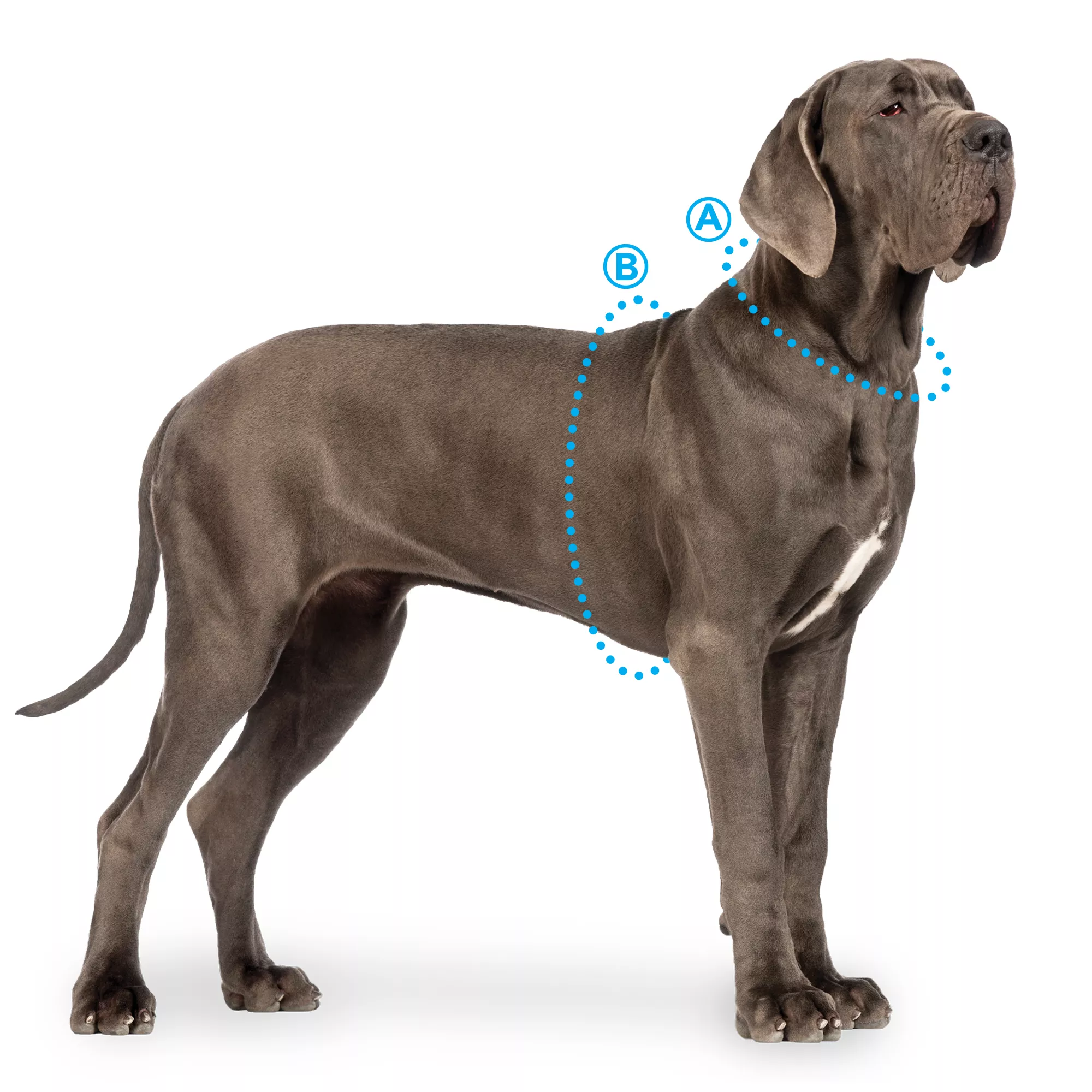
Proper sizing of products is crucial to the safety and comfort of the dogs and cats wearing them. However, we understand it can be a confusing process for pet owners. Use these visuals as a guide for how to measure dogs properly for a collar, harness, or vest.
A Perfect Fit
How to Measure for Collars and Harnesses

A. Neck: Collars should sit up higher on the neck, so measure here when determining collar size.
B. Girth: Wrap the tape measure around the broadest part of the dog's rib cage.
Measure first!
Dogs come in all different shapes and sizes and therefore, each has a unique fit. The best way to fit them properly is by using their measurements first and their weight range second.

X-SMALL
Up to 15 lbs
- Dachshund
- Shih Tzu
- Yorkshire Terrier
Collar Size:
8"-12"
Harness Size:
16"-19"

SMALL
20 - 35 lbs
- Beagle
- French Bulldog
- Miniature Schnauzer
Collar Size:
10"-16"
Harness Size:
19"-23"

MEDIUM
30 - 50 lbs
- Australian Shepherd
- Bulldog
- Shetland Sheepdog
Collar Size:
14"-20"
Harness Size:
22"-28"

LARGE
50 - 80 lbs
- Boxer
- German Shepherd
- Labrador Retriever
Collar Size:
18"-26"
Harness Size:
28"-36"

X-LARGE
90 - 150 lbs
- Great Dane
- Mastiff
- Rottweiler
Collar Size:
20"-28"
Harness Size:
30"-43"
How to shop for your size
In the highlighted example below, 1 inch is the width of the collar and the range is 18 inches to 26 inches.

When shopping in stores, look towards the top of the hang tag for the size and range.

Chain Collar Sizing
To properly fit a chain collar, add 4 inches to the circumference of your dog's neck. This ensures there is enough length for the collar to function properly.
Then, use their weight to determine the proper gauge of chain.
For example, if your dog's neck is 18 inches, add 4 inches. Your dog will need a chain collar that is a minimum of 22 inches long. If your dog weighs 60 pounds, he will need a 2.5 mm gauge chain.


Titan Prong Collar Sizing Guide
(Chrome-Plated Steel)
- Choose the wire gauge according to your dog's weight.
- Size your dog's neck and add 2 inches.
- If collar length needs to be adjusted, add or remove links accordingly.
Note: Collars should sit higher up on the neck, so measure here when determining collar size.
For example, if your dog's neck is 18 inches, add 2 inches. Your dog will need a prong collar that is a minimum of 20 inches long. If your dog weighs 70 pounds, the gauge should be 3mm.
Wire Gauge According to Weight
| Up to 66 lb (30 kg) | 2.25 mm |
| Up to 77 lb (35 kg) | 3 mm |
| Up to 88 lb (40 kg) | 3.25 mm |
| Up to 154 lb (70 kg) | 4 mm |

Measure Your Dog for the Perfect Muzzle Fit
Measure First!
Dogs come in all different shapes and sizes and therefore, each has a unique fit. The best way to fit them properly is by using their measurements first and breed second.
How to Measure
Snout circumference: the circumference of the widest part of dog's muzzle, typically just below the eyes.
Length: The distance between the tip of the nose to the base, just below the eyes.
To measure nose circumference, carefully wrap the tape measure around the dog's snout. This should be done 1/2" below the dog's eyes.

